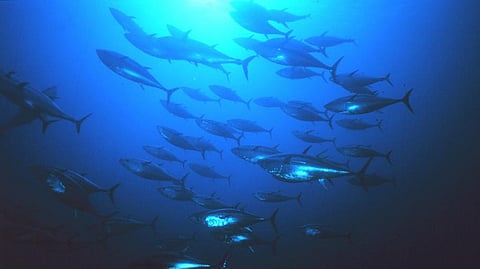Study shows marine protected areas boost fish populations across California's waters
An international team of researchers, led by scientists at UC Santa Barbara, have evaluated the effects of California's network of marine protected areas (MPAs) across different species and habitats and found that such areas offer many benefits to sea life, especially those targeted by fisheries.
The authors found that older MPAs, and those with a greater diversity of habitats, showed the highest amount of fish biomass, especially in targeted species, like rockfishes.
Stronger protections also correlated with more pronounced results. With international targets aiming to protect more of the world’s oceans, the findings can inform approaches to MPA design and networks that span multiple ecosystems.
In 1999, the California Legislature passed the Marine Life Protection Act (MLPA), which required the state to overhaul its marine reserves. The legislation prompted the creation of the first statewide MPA network in the United States, and one of the most extensive in the world.
"This huge, state-wide network, and its comprehensive design process, was sort of revolutionary at the time,” said co-author Cori Lopazanski, a doctoral student at UCSB’s Bren School of Environmental Science and Management.
"The state invested a ton of time and energy into designing this network of 124 marine protected areas [using the best science of the time]," said Joshua Smith, a former postdoc at UCSB and now an ocean conservation research scientist at the Monterey Bay Aquarium as well as the study's lead author.
Synthesising disparate data
Rather than close a giant area of the ocean, the state decided to set aside a constellation of smaller protected areas distributed across the coast. They specifically engineered the network to enable the interchange of animals, plankton and nutrients between different reserves.
In 2021, scientists converged in Santa Barbara for a working group to inform management recommendations and decisions. The effort was hosted by the National Center for Ecological Analysis and Synthesis (NCEAS), a National Science Foundation research center at UC Santa Barbara.
Twenty-four scientists collaborated on the resulting paper, which sought to determine the conservation performance of 59 MPAs in California’s MPA network.
To this end, the authors considered the number of species present in an area, the relative abundance of different species and the overall biomass. In this case, the researchers looked at pounds of fish.
The researchers compiled long-term data on 170 taxa from the MPA monitoring efforts of four groups, each focused on a different habitat: the surf zone, kelp forest, shallow reef and deep reef.
The four monitoring groups had very similar data, but they collected and notated in different ways. Authors therefore had to clean and synthesise the disparate data sources.
"For each sampling method, we compared what’s inside the MPA to what’s outside,” said Cori Lopazanski, a doctoral student at UCSB’s Bren School of Environmental Science and Management. "Once you have that difference, then you’re just dealing with ratios."
"Now we could take all of that information and put it in a single analysis that tells us something about how the MPA is performing across all of those ecosystems," Smith added.
Gains made across the board
Overall, the authors found that MPAs increased fish biomass across the whole network. This primarily came from species targeted by fisheries, which suggests that the protection from fishing really does help boost their population health.
Biomass can change in two ways: more fish and larger fish. Although their analysis didn’t distinguish between the two, the authors suspect the gains were a combination of both.
A few characteristics seemed to correlate strongly with conservation benefits. MPAs with more stringent protections saw greater gains, as did areas that had previously experienced heavy fishing. Older MPAs also produced more significant results.
"Many fish in California are slow growing and take a long time to mature," Smith said. "So it makes sense that the benefits of MPAs are going to take time to actually manifest."
Habitat diversity also emerged as a major predictor of success. Although scientists and fishermen often classify species by their preferred habitat, a single fish may move between habitats from day to day.
"If you have different habitats in proximity to each other, then there’s more variability in the types of resources, foods, shelters — the types of things fish need to survive — in the space where they’re living," Lopazanski said.
Including diverse habitats within an MPA ensures that fish don’t have to leave an MPA to seek these things out.
Interestingly, none of these features appeared to influence the number or relative abundance of different species present. Smith suspects the former may stem from California’s past stewardship. The state has boasted strong fishery management for decades, so few species were completely gone from any area, he explained.
As for the other marker of diversity, protection can increase the number and size of fishes without necessarily changing the relative abundance of different species.
New analysis validates past decisions
"It was exciting to see that all of the planning and design that went into putting this huge network into place was producing many of its intended benefits," Lopazanski remarked.
One of the strengths of a marine reserve is that it can protect large areas with many species.
"MPAs are always designed to protect multiple habitats, but they are rarely evaluated with all of the different habitats in a single study," said Jennifer Caselle, a research biologist at UCSB. "And that’s in part because scientists specialise. But California supports broad monitoring efforts across its marine reserves, and this paper analyses all these habitats at once."


